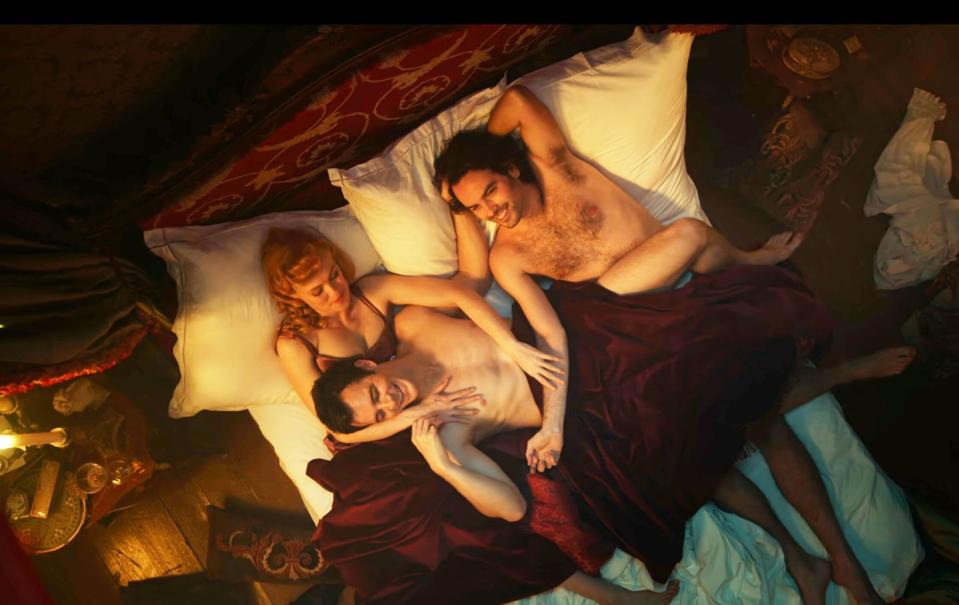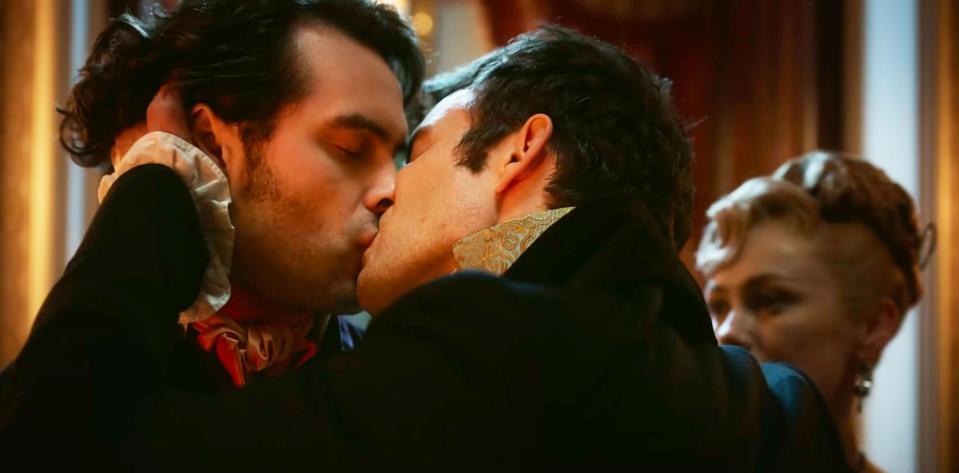Throuples are everywhere right now—and there’s a good reason why

WARNING: BRIDGERTON SPOILERS AHEAD.
In the third season of Bridgerton, second son Benedict (Luke Thompson) appears to have found his match in Lady Tilley Arnold (Hannah New).
She's older, worldly, and widowed. Essentially, Lady Tilley is the complete opposite of any woman he'd find on the marriage mart. In episode six, she introduces him to her 'dear friend' Paul Suarez (Lucas Aurelio)—and Benedict's mindset truly opens up.
During the episode, Benedict, Tilley, and Paul share a night of drinking and dinner. After Paul and Benedict share a sexually-charged smoking session, Paul leaves to share a steamy kiss with Tilley—and the duo invite Benedict to join.
The three go to bed together. Afterwards, Tilley tells him that she'd like to make it official—just the two of them. But Benedict's views have permanently shifted.
'What happened between the three of us—what has happened ever since I met you—has made me realise how good it feels to be free,' he says. 'You've opened my world, and I'm not ready to close it again.'

When Tilley asks if he's breaking up with her because of Paul, Benedict replies that gender no longer matters to him. 'Paul could be Patricia, or Paulie, or all three at once,' he says.
Benedict's encounter with Tilley and Paul isn't the first time that sex between multiple partners have been featured on Bridgerton. In Season 1, Benedict has a threesome at an art party, and even the previously-nerdy Colin (Luke Newton) sleeps with two women at once upon returning from his months abroad.
But it is the first time the show has delved into the world of polyamory, a term meaning 'multiple loves.' Although Tilley, Benedict, and Paul don't end the season in a committed and closed-off throuple, Benedict is now ready to investigate the world of dating multiple partners.

This year has been full of throuples in films and television, from Challengers' tension-filled love triangle to US network Peacock's dating show Couple to Throuple. Everywhere you look, trios are the new duo.
In media, non-monogamy has been steadily gaining traction over the past few years: Take the 2023 Riverdale finale, where Archie, Veronica, Jughead, and Betty ended the series in a romantic 'quad,' or the Gossip Girl reboot, where Audrey, Max, and Aki enter into a three-way relationship, as examples.
But it seems like 2024 has honed in on the throuple, also called a triad: a balanced, consensual, and committed relationship between three people. Throuples can be closed (meaning members of the trio only date one another) or open (meaning members of the trio could date or have sex with other people).
The phenomenon surprises sex therapists like Rachel Wright, LMFT, and Tamara Pincus, LCSW.
'It's actually one of the most perplexing dynamics in non-monogamy to navigate,' Wright tells Women's Health. 'A three-person relationship brings up challenges that other relationship designs just simply don't. It's worth it, if that's what feels good, but it's certainly not easy way.'
'Throuples are so much less common than other forms of polyamory,' Pincus adds. 'So it's kind of wild that, now that we're pro-polyamory, everything is about throuples.'
So why are throuples so popular in film and TV right now? And did they even exist during Regency-era England? WH investigates.
Meet the experts: Sarah Richardson, humanities professor at the University of Glasgow. Tamara Pincus, LCSW, a certified sex therapist specialising in polyamorous and LGBTQIA+ clients and co-author of It's Called Polyamory: Coming Out About Your Non-Monogamous Relationships. Rachel Wright, LMFT, a relationship, sex, and mental health therapist based in New York.
Throuples were around during the Regency era.
Polyamory has been around for hundreds—if not thousands—of years. While the term 'polyamory' was coined in the early 1990s by a group of ethical non-monogamists, the practice itself has been around since the early 20th century, per TIME. The indigenous Mapuche people—who practiced polygamy in Chile before the Spanish arrived in the 16th century—are an even earlier example of non-monogamy, Wright says.
So it makes sense that throuples—or, as they were called back then, ménage à trois (taken from the French phrase meaning 'household of three')—did happen during Bridgerton's Regency era, according to historian Sarah Richardson. However, they weren't exactly the same as Benedict's situation.
Since aristocratic women were typically married off young for wealth or influence, they (or their families) wouldn't want to ruin their changes on the marriage mart by being caught in a relationship before her nuptials. However, once wives were married and produced an heir, high-status relationships could turn into 'marriages of convenience,' where both members were allowed more sexual freedoms.
'Sexual behaviour was quite strictly controlled in public,' Richardson tells Women's Health. 'However, behind closed doors, and particularly for aristocratic women who have produced an heir, things often were a lot more flexible than they might seem. As long as it's not too obvious, you could get away with a lot.'
And behind closed doors, a lot was happening: At that time, around one-fifth of people were infected with syphilis, she says. 'That, to me, demonstrates the licentious nature of relationships during that time period,' Richardson adds.
During the Regency era, the most common ménage à trois happened between two women and a man, with one woman being the man's wife and the other a live-in girlfriend, Richardson says. The most famous example was between William Cavendish (the Duke of Devonshire), his wife Georgiana, and Lady Elizabeth 'Bess' Foster, who was separated from her husband and came to live with them. Bess had two children by the Duke, and, according to their letters, the women had 'quite a close relationship,' she says. Another famous example includes Frankenstein author Mary Shelley, her husband, and her stepsister Claire Clairmont, who was known to travel with the Shelleys, Richardson says.
But similar to the show, the trio wasn't out in the open. They had to be kept very discreet so they wouldn't be publicly ridiculed or ostracised. The Duke of Devonshire and Georgiana, who were somewhat infamous for their living arrangement, were featured in a number of insulting printed caricatures; meanwhile, in a real-life version of Lady Whistledown's column, Town & Country magazine ran a series called 'Tête-à-Tête' in which a man and a woman's faces would be printed alongside all of their relationship rumours.
'[In caricatures,] Georgiana was often-portrayed as half-dressed. There were images of her having to change Bess' baby's nappy,' Richardson says. 'Women always got the rough end of the stick.'
And for women, word of their polyamorous relationship getting out could affect their social lives, too: If a woman got pregnant by a man who wasn't their husband, she'd be sent to live abroad or in the countryside for a period of time.
'People could get excluded from social gatherings because of their alleged behavior,' she says, adding that, at that time, there was a fascination with so-called 'dysfunctional relationships and gossip.'
Richardson isn't aware of any well-known Regency-era relationships between two men and a woman, though it can be difficult for historians to tell what really went on behind closed doors. But like Benedict's Lady Tilley Arnold, it was far easier for a woman to navigate a ménage à trois once her husband died and she had already produced an heir.
'It would be very difficult for a single woman to do any of this, because you would then be damaged goods and totally ostracised from society,' she says. 'It's almost like marriage gave women that safety net, as long as they produce an heir, which was all that they were married off to do so.'
'That's why you get these older married women who tend to be the ones who are engaging in these sort of relationships,' Richardson adds.
So Benedict's situation—which involved an older, already-married woman—could have been possible in the Regency era.
There are a few reasons why 2024 is the year of the throuple.
Pincus believes the closed throuple is suddenly everywhere because it's the closest arrangement to a monogamous couple that you can get while still being polyamorous. (Other forms of polyamory include swinging, open relationships, polycules, and more, according to Wright.)
'I feel like people think it's less threatening to be in a triad than it is to know that your partner is dating somebody else that you don't date,' Pincus says. 'People, fundamentally, go to a place in their mind of like, 'Oh, that feels like cheating.' That feels scary or threatening.'
Wright agrees, adding that, for many people, the 'closest thing' to a monogamous norm is adding another woman to an existing heterosexual relationship. 'That is the most accessible idea to people, and I think that that then becomes the 'easiest' thing' to represent in media, she says.
But being in a throuple isn't necessarily an easy dynamic, and can come with many unique struggles that monogamous and other polyamorous folks don't face. 'The world is designed for two people, so someone is going to feel being that third in almost every circumstance, whether it's getting on a ride at Disneyland or a couple's massage,' Wright says. 'Everything is for two, and that inherently creates this dynamic of, 'Well, am I going to be in the two, or am I this odd man out?''
In a true, non-hierarchical throuple, no one is the 'odd man out,' but 'it's certainly easy to feel that way,' she continues.
If you're feeling inspired to try something new, you can dive in.
While throuples aren't necessarily the easiest dynamic to navigate, they can become incredibly rewarding relationships, Wright and Pincus say. They recommend educating yourself on polyamory, whether that's through polyamorous meet-ups, workshops on ethical non-monogamy, or books like The Ethical Slut by Janet W. Hardy or Opening Up: A Guide to Creating and Sustaining Open Relationships by Tristan Taormino.
Pincus also recommends educating yourself on the 'classic' mistakes that can happen with early-stage throuples, for example focusing on the new partner and not necessarily paying attention to the existing relationship.
Overall, communication is key to a healthy, strong trio. 'When you start dating, it's really good to have an aftercare plan set up,' Pincus says. 'If my partner's going on a date with someone or we're going on a date with someone, how are we going to take care of each other afterwards so that we can feel safe and secure in our relationship and not threatened?'
Wright underscores the importance of education, urging people who are curious to take in everything they can. 'Learn a little bit about the different things that fall under the non-monogamy umbrella. Even if you aren't sure you'd be into some of it, learn about it,' she says. 'There's no harm in learning, just like there's nothing wrong with monogamy.'
'The only thing that can be wrong with monogamy is thinking it is the only choice and doing it by default, without really choosing it,' she adds.
More resources for a healthy, happy relationship...
Cut through the noise and get practical, expert advice, home workouts, easy nutrition and more direct to your inbox. Sign up to the WOMEN'S HEALTH NEWSLETTER
You Might Also Like



